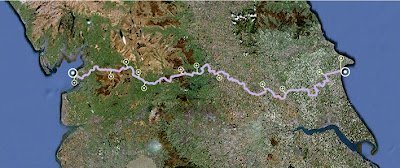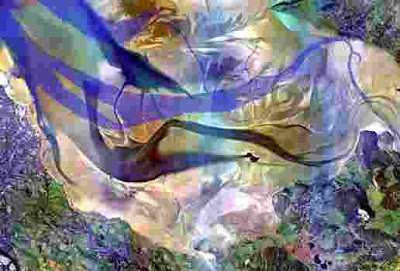 |
| The route of the Way of the Roses across Lancashire and Yorkshire - showing the sites for proposed artworks: two Terminus works and 10 Passing Places (small diversions from the main route) |
‘Travelling Histories’
• A Coast to Coast artwork to accompany the Way of the Roses
• Two Terminus works - one at either end of the route (Bridlington and Morecambe)
• Main theme established in the contrast between the Terminus works
• A series of artworks along the route called Passing Places – marking places where
movements of people or phenomena have coincided with the route in the past
movements of people or phenomena have coincided with the route in the past
Each Passing Place comprises:
• a destination (historical/cultural - of local significance)
• a constituency (local group or individuals to steer project)
• an artist
• an overall creative direction (from lead artist)
• an artwork (permanently sited in landscape)
• an orientation point within the nearest local community
Main Conceptual Theme - Transformation through Movement
This overall theme is developed across the route through the smaller Passing Places projects, but the foundations of the theme are established in the Terminus artworks. The theme grows from consideration of the contrasting landscape dynamics at work at either end of the route.
The landscape at both ends of the Way of the Roses the landscape takes shapes immediately recognisable as those made by running water. At one end this is an ongoing process that makes newly shaped land every day, at the other, the land retains the memory of movement that occurred at a very precise moment in the past.
 | ||||||
| Montaged geosatellite image of Morecambe Bay showing the moving path of the River Kent around the ‘Sands’. Every low tide at Morecambe reveals a newly carved landscape of ‘gulleys’, ‘gutters’ and ‘dykes’ (cf Cedric Robinson).
|
 |
| View from the Morecambe Promenade at low tide |
Passing Places
The second part of the overall artwork proposed for Way of the Roses is called Passing Places.
 |
| Marker on old monastic route near Fountains Abbey |
• There are approximately 10 Passing Places planned along the route between the two Terminus artworks
• Each Passing Place is a short diversion from the main route
Building on the research finding that Way of the Roses is remarkable for the number of visible traces of human activity in transforming the landscape - Passing Places is themed around places where traditional routes and historical events have either crossed or passed near the Way of the Roses route.
 |
| Former Quarry Incline - Pately Bridge. Used to slide stone down from the quarry to the railway below |
One of the clear aims of the artwork project was to stimulate connections between local communities and the cycle route. Passing Places is built around the idea that if a local person met a traveller, they might well show their visitor something special in their locality.
Each Passing place will be developed by a local steering group and the physical artwork commissioned by the steering group from a locally based artist or artist of local origin
Lead Artist (of the overall project) to work with the local steering group and commissioned artist to ensure high quality and relevance in each individual work and cohesion with the overall project ‘Travelling Histories’



Matt,
ReplyDeleteWow this is some undertaking - looks so good though. On an initiative like this how will your time be spent in terms of: research, consultation, sourcing and the actualities of doing?
All the very best to you and yours
phil et al
Hi Phil
ReplyDeleteThanks for dropping by.
The answer to your question has to be 'pass' - I don't really think about how the different bits break down (probably should do!). As things stand I have spent 3 months researching and talking to folk and come up with a conceptual framework (above) for an artwork process to accompany 'Way of the Roses'- from here on in I will be responsible for making the two 'terminus' artworks and co-ordinating the overall vision/collaborating with other artists on the 'passing places' projects.
I do like to work in this way ie with one eye on the big picture and the other obsessing about the details of physical making.
M
Easy, Matt
ReplyDeleteMakes sense to me, perhaps you don't really need to consciously concentrate on the whole thing perhaps it just happens because of all your previous experiences and collaborations!
Good luck with it all.
See you on the 21st
Regards
phil
Hi Matt,
ReplyDeleteI like the sound of this project too, maybe because Lancashire was my home ground and because I'd love to cycle it and see what I find along the way. I'll keep an eye open for more info. I've done the coast to coast and quite fancy another trip like that.
h